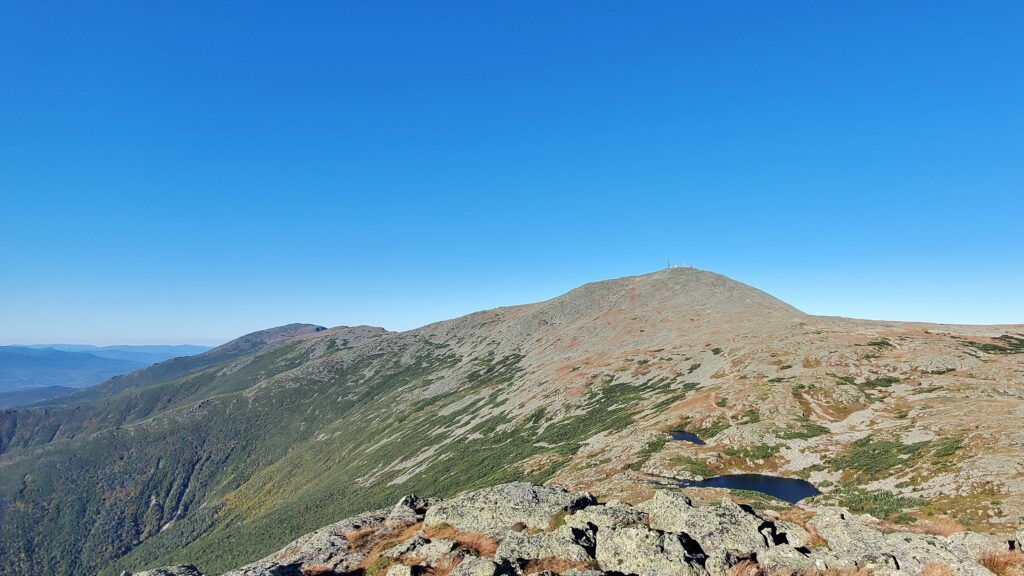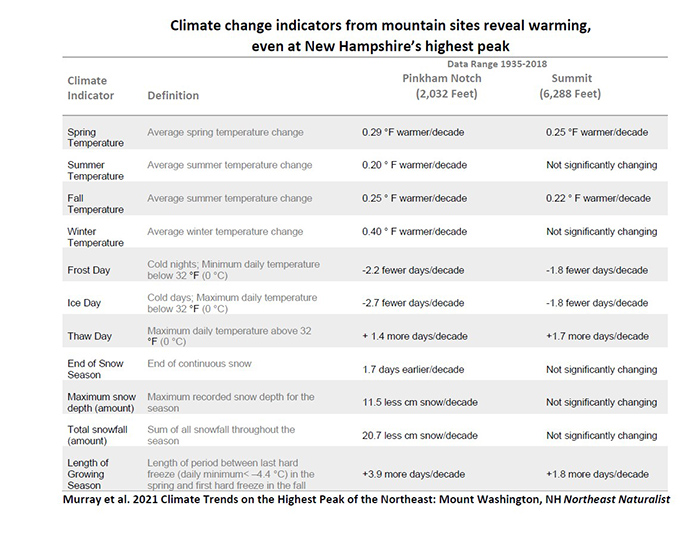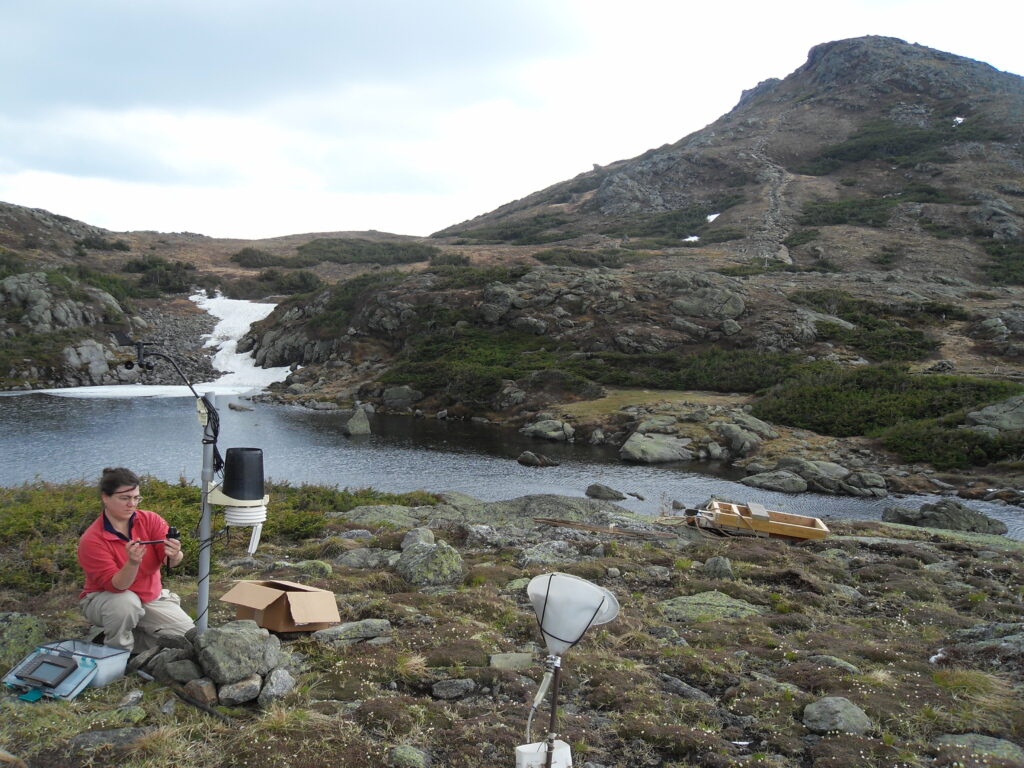Mountain Washington’s Response to Climate Change Now ‘Statistically Significant,’ Research Shows
Observatory Provides the Only Data Source for Measuring Climate Trends on White Mountain Peaks
By MWOBS Staff | December 28, 2021

A Sept. 2021 view of Mount Washington from the summit of Mount Monroe, with Lakes of the Clouds below the summit cone. Researchers rely on Mount Washington Observatory’s near century-long data set to track climate trends in the White Mountains. If you value this work, consider supporting our mission.
Given the Northeast’s quickly warming climate, a key question attracting the attention of scientists like Georgia Murray is, how are mountains responding?
Are summits of the White Mountains warming as quickly as lower elevations? Or are these peaks—with their diverse weather conditions, unique alpine environments, and immense appeal to outdoor enthusiasts—enjoying some degree of protection from climate change due to their height in Earth’s atmosphere?
Getting to answers starts with long-term data. Unfortunately, as Murray and her colleagues point out in a recent study, the shortage of data collection at remote mountaintops hinders understanding of higher summit responses to human-caused carbon dioxide emissions during the last 170 years.
“Long-term and robust meteorological measurements in the Northeast mountains are sparse,” writes Murray, a staff scientist at the Appalachian Mountain Club (AMC). “Fortunately, the summit of Mount Washington has one of the longest (since 1932) high-quality montane data sets in the world.”
Mount Washington Observatory (MWO) remains the only active meteorological station above 2,300 feet in the mountainous regions of New England that has both an extensive and continuous climate record.
“The quality of the data is exceptional. There is no other upper-elevation data set that can really compare,” said Murray when we caught up with her recently.
In their recent paper, “Climate Trends on the Highest Peak of the Northeast: Mount Washington, NH,” lead author Murray and her colleagues build on previous studies of MWO’s data set, which now spans nine decades. They incorporated new meteorological data collected over the last 15 years at the Observatory’s summit weather station (6,288 feet) and nearby Pinkham Notch (2,025 feet), a mid-elevation site where daily temperature and snow data have been collected since 1935.
“The comparison of these two sites provides a proxy for climate-change patterns across an elevational gradient in the northern Appalachian Mountains,” Murray writes.
In other words, although the scarcity of data at higher summits in the Northern forest remains a challenge to understanding climate change on mountains, such understanding is possible only because of the continuous data collected by MWO and the cooperative station at Pinkham Notch, combined with research like that of Murray and her colleagues.
Until now, research showed that Mount Washington’s summit had not yet tipped towards a significant warming trend, in stark contrast to sharp rates of change at lower elevations in the northeastern US, which is warming faster than other regions. As Murray points out, “80% of climate-model projections indicate that this region will cross the 2 °C [3.6 °F] warming threshold by 2040, a full 20 years ahead of the global temperature meeting this same marker,” incorporating research by Karmalkar and Bradley (2017).
Scientists believe the summit continues to be buffered from the Northeast’s exceptional rate of annual warming, but not to the extent previously shown. The recent data analyzed by Murray show that statistically significant warming is in fact taking place at both Mount Washington’s summit and Pinkham Notch.
“Warming rates and significance at both Pinkham Notch and the Summit site increased with the additional 15 years added to the record since the previous analysis by Seidel et al. (2009). Summit annual temperatures are now increasing at a statistically significant rate, although still at a slower rate than Pinkham Notch,” Murray writes. “The most recent 15 years have been the warmest period on record globally. This accelerated rate of warming regionally and in our study is consistent with the continued rise of greenhouse-gas emissions.”
The new study also adds insights about climate indicators at Mount Washington and Pinkham Notch from the 1930s through 2018, including snow season start and end, frost days, ice days, thaw days, snow depth, snowmaking days before Christmas, and growing season start and end, similar to those developed by Contosta et al. (2019).
“We used the data but looked at it from a different lens,” Murray said. “We looked at winter conditions and other indicators that people generally talk about, like snow arrival.”

All monthly minimum and maximum temperature trends were warmer, though not all significantly so, at the summit and Pinkham Notch, except for maximum temperatures during October at Pinkham Notch and June at the summit.
“We definitely are seeing the signal of climate warming at these two sites,” Murray said during her recent Science in the Mountains presentation.
The average annual temperature is warming 0.18 °F per decade at the summit and 0.25 °F at Pinkham Notch. Evidence of a changing winter season, while happening at both sites, is most dramatic at Pinkham Notch, where the average winter temperature is warming 0.40 °F per decade. This trend is consistent with what is being observed at lower elevations across the region.
On the summit, spring is warming fastest, at about 0.25 °F per decade on average.
Other climate indicators provide a sense of the condition of winter at higher elevations in the White Mountains. Mount Washington’s summit is experiencing 1.8 fewer frost days (minimum daily temperature below 32 °F) per decade and 1.8 fewer ice days (maximum daily temperature below 32 °F) per decade. The length of the growing season on the summit is also increasing at 1.8 days per decade, potentially changing the life cycle of alpine plants and flowers.
“Even though the summit has some different warming trends statistically, I think it is starting to catch up. Because of those other indicators, we think the summit will soon be on its way to warmer winters and what we are seeing elsewhere,” said Murray, who grew up in Freedom, NH and earned her master’s degree from the University of New Hampshire with a focus on biogeochemical cycling. That means she studies how elements like carbon or sulfur move through Earth’s atmosphere and biosphere and impact ecological systems.
A member of AMC’s research department, Murray focuses on science and monitoring in the White Mountains, bringing a science-based perspective to conservation and policy work, such as greenhouse gas reduction programs to address climate change.

Georgia Murray sets up AMC’s long-term cloud and rain monitoring site at Lakes of the Clouds Hut. AMC photo.
A core theme of Murray’s career entails diving deep into data to emerge with knowledge that puts climate change in a relatable context. “Understanding the impacts of climate change is very much about how we make it relevant to us. What is it doing locally, and what is it doing globally? We know it is happening, but what is it doing in our back yard.” Murray said.
On the other hand, she added, “we need to be careful about looking at local trends and not generalizing them globally but look at the whole system.”
With the AMC, her key interest is how climate change is playing out in mountains. The organization and its hiking membership care deeply about alpine environments as a resource. Access to MWO’s unique data set along with support from scientific staff at the Observatory’s summit weather station solves a critical challenge, providing researchers at AMC and other scientific organizations with the only source of continuous data for understanding how climate change impacts higher summits in the White Mountains.
If you value MWO’s high-quality data set for understanding climate trends, consider a donation to Mount Washington Observatory, a private, nonprofit institution. Donations from members and corporations are an important source of funding that directly support the continuation of forecasting, climate data, and educational work at the summit of Mount Washington.
To delve deeper into Murray’s study, watch her recent Science in the Mountains presentation.
Team Flags Return for Seek the Peak’s 25th Anniversary
Team Flags Return for Seek the Peak's 25th Anniversary By MWOBS Staff Mount Washington Observatory is looking forward to continuing a much-loved tradition for Seek the Peak’s 25th Anniversary: Team flags. In inviting teams
Meet Summer Interns Zakiya, Max and Maddie
Meet Summer Interns Zakiya, Max and Maddie By MWOBS Staff We are excited to welcome six teammates to the summit of Mount Washington this summer! During their internship, these students and graduates will play
Saying Goodbye to the Summit
Saying Goodbye to the Summit By Alexis George After an extraordinary last three years working as a Weather Observer and Meteorologist, I am excited to pursue a different career. As sad I as am




